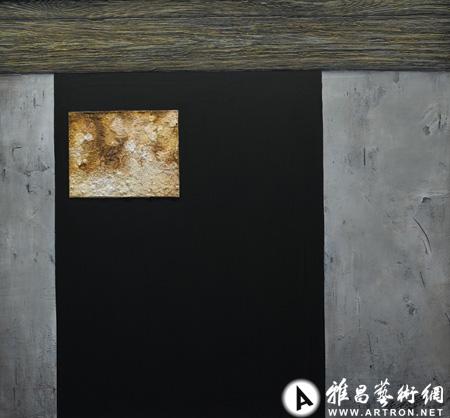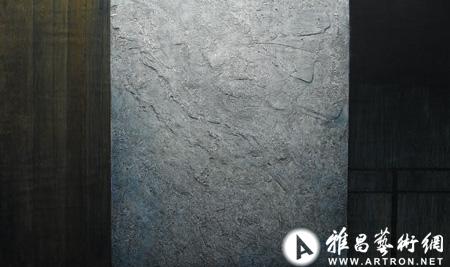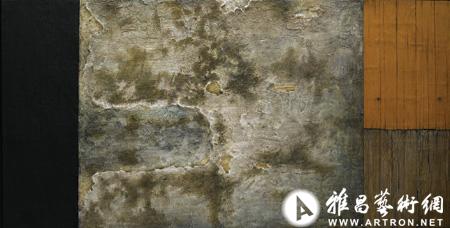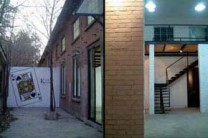乡关日暮梦里情怀
2011-04-15 11:31:21
应天齐的艺术探索始于上世纪80年代,他在西递的建筑中发现了形式之美。80年代正是前卫艺术风起云涌之时,西方现代艺术成为很多人追随的目标,这种追随总是有着很大的盲目性,尽管精神可嘉,却丧失了原创和传统断裂。其实这正是应天齐思考的问题,与其说他发现了西递,不如说他发现了现代。
传统是多样的,为了实现现代艺术的中国方式,大量的传统符号(或中国元素),如水墨、书法、戏曲等,被纳入现代艺术的样式,但大多流于形式的浅薄。传统的意义并不在于现代对传统的重复,而在于现代的缺失要求对传统的重新发现。作为现代艺术,应天齐的起步并不是很张扬,从一开始,人们还很难认识其作品的现代性意义。他的早期作品,如《西递村系列》和《徽州之梦系列》,现代性似乎被深深地隐藏,人们看到的是现实主义与版画语言的强化,现代主义艺术的基础——几何形的平面构成隐藏在这种“版性”之中。从表面上看,应天齐并不是追求现代性,水印木刻本来就盛行于江南一带,传统与地域性的媒材本身就具有文化的规定,用这种媒材再现徽州民居似乎是传统的一种延续,艺术家不过是采用了新奇的观察角度。在上世纪80年代西方化的语境中,这种表达似乎不受前卫艺术的关注,即使像徐冰、吕胜中那样非比寻常的中国元素,也完全是在西方当代艺术的样式中。实际上,应天齐的表现并不传统,他不是直接采用现代的形式,如抽象化或表现性的处理,而是强调了人的因素,人在画面上隐性地存在,人的凝视,人的观察,也暗示着人的记忆。人的在场是应天齐作品的重要因素。这种性质贯穿他的整个创作,传统与现代也是结合在这种个人的因素中。从形式上看,这种个人性体现为视角的与心理的两个层面。在《徽州之梦》之十(2000)中,画面的主体是黑色与白色,景物只占很小的部分,白色的部分如同天空把房屋压缩在地平线上,黑色则如同窗格和墙面,观众透过窗户看到远处的景色。这是一种观察角度的变换,熟悉的景物在变换的视角下变得陌生和疏远。窗格与墙面是隐性的抽象构成,与再现的房屋形成强烈的对比。这是现代艺术形式的运用,也反映了他对现代艺术的追求。但对他来说,形式只是表现的手段,不是目的,形式的内在意义可能他自己都没有明确的意识。观众仿佛是透过窗户看到外面的景色,观众的位置实际上是被画家规定的,也就是画家自己的位置,是他自己从这个位置来观看和凝视。主体的在场暗示了作品的主题,对象是正在消逝的客体,它不仅是历史的痕迹,也是记忆的碎片,它的美不在自身的形态,而在主体的感知。它的消失不仅抹去了一段历史,也抹去了我们生命的来源。我们不是从应天齐的作品中认知徽派建筑的形式或形式之美,而是感受沧桑和悲凉,那被重新发现的和正在消逝的,正是我们生命的一部分。这种通过形式体现的精神与心理的隐喻在他的早期作品中就有了伏笔,如《西递村系列》,大面积的黑色占据画面的大部分空间,房屋被挤到画面的一角,或显现在黑色方块的夹缝中。黑色虽然是版画的主要语言,但在这儿不是作为单纯的版画效果,同样有心理的隐喻,尤其在《西递村系列》之《古巷》(1991)中,大面积的黑色不只是起到衬托形象的作用,而且是有效的空间实体,它像个人的记忆或集体无意识,历史的陈迹从记忆的空间浮现出来。实际上,这也是应天齐作品中隐藏的主题,梦回西递,是对历史的沉思,也是个人生命的记忆。
无法排遣的相思成为应天齐的一个矛盾,也有力地支撑其艺术的发展。一方面是对历史、生命的不断回首,一方面又是对新艺术的不懈追求,这种关系构成其艺术的主要特色。尤其值得一提的是他在抽象艺术上的实验,就是他的《砸碎黑色》。尽管这个作品可以视为行为和装置,但其观念还是来自他的版画,来自那些抽象的元素。抽象艺术介于他的版画与装置之间,在时间与观念上都是一个过渡。通过对其版画作品的分析,可以看出其抽象的意义。在其版画作品中,已经隐含抽象的因素,黑色的块面不仅指示着实体(窗格、墙面),也暗示着心理,是凝视,是记忆。它与形象构成直接的对比,却比形象有更大的力量。应天齐的抽象作品就是把版画中的黑色抽象出来,在黑色的形式后面是个人经验的叙事。在应天齐看来,历史的消逝不是一个自然的过程,而是人为的破坏,不仅是在时间中遗忘,还有现代文明对历史的蓄意割裂。因此他那些黑色的碎片有双重的含义,一个是被割裂和被泯灭的历史,一个是历史被泯灭在现代的形式中,因为抽象艺术本身就是一种现代表现。应天齐的艺术并不好理解,表面上看很简单,其实隐藏着复杂的语言符码,如同他的黑色抽象,任何一个黑色的碎片都不是指示形式的行为,其意义包含在其前在的艺术中,不过,当他采取这种行为的时候,可能他自己都没有意识到前在的艺术对其行为的规定,和观众一样,他可能也沉浸在新颖的形式和大胆的实验上。

失忆(油彩、乳胶、塑形胶、木皮) 122*130cm 2007年

天井(油彩、乳胶、塑形胶、木皮) 120*200cm 2007年
应天齐的创作总是在单纯中蕴含着复杂,他的装置作品就是如此。由于是一种平面的关系,这类作品一般被称为综合材料,但从另一个角度来说,也可以称为平面装置。之所以强调装置,就在于装置与现成品的关系。在某种意义上说,应天齐的综合材料都是仿真的现成品。不同的是,他的现成品是仿真的替代,挪用了现成品的概念,材料与现成品相辅相成,既有材料的表现力,也有现成品前在和挪用的意义。从理论上说,装置并不类同于绘画或雕塑的形式,因为它重在观念的表达。对于应天齐来说,他的观念还是隐藏在形式下面,他的装置首先还是视觉关系的表达,但不是一般的形式意义,而是由文化赋予的意义。材料的运用,使他直面历史,因为材料本身隐含历史的信息。经过他的重新编码,生发新的意义。以作品《裂开的墙》(2007)为例。从大的形制上,我们感觉到他的历史的双重影响,即绘画与抽象。不过,绘画的形象被材料(现成品)所取代,而抽象则转换为纯粹的视觉关系。应天齐在形式的把握上有先天的优势,空间关系的布置,黑白灰的处理,使得他的抽象首先以强烈的审美效果吸引人。形式的力量已使他的作品趋于完整,实际上,其意义远非如此,抽象的构成不只是形式的审美,而是历史与文化的冲突。这种巨大的张力正是通过材料与形式的冲突而形成的。作品的主体是垂直的黑灰色和水平的褐灰色,两个色块都是硬边的切割,色块里面是用塑型胶和石膏制作的沧桑的墙面,其中一块还有从斑驳的墙面中露出的木皮。审美发生了转换,历史在这儿被精致地切割,抽象不是意味着审美与构成,而是现代、工业、甚至西方,对我们的传统与文化的切割和侵犯。但是这一切都是在审美中完成,传统与现代在表面上是无缝对接,而实质上是历史进程的无奈。在作品的上方有两块黑色,似乎是构成的需要,但它使我们想到他的版画,那种在场的暗示,即使他对历史,对传统,对生养他的土地有最深沉的爱,但文明的进程不可避免地将那种留恋深深地掩埋。

消失的故事(油彩、乳胶、塑形胶、木皮) 122*244cm 2007年
在应天齐的作品中,老墙是反复出现的一个主题,在《失忆》(2007)中,一块墙面悬置在黑色的空间,当它被黑色吞噬的时候,也是记忆的最后消失。在《木雕之二》(2008)中,一块木雕镶嵌在老墙和黑色的背景中,老墙似乎正在上升,最终掩盖的不只有木雕,还有黑色的记忆本身。像这样的作品,很难阅读出直接的象征性,而且他也不追求明确的象征,他追求材料的表现力。不管是挪用还是仿真,这些材料都是来自家乡的老屋。他相信,在这些行将消失和遗忘的东西里面有一种真正的力量,召唤历史,召唤生命。它既在现代中消逝,又被现代所照亮。当我们迷失在现代的时候,总是会问精神家园在哪儿,应天齐的作品是不是作出了回答,因为传统与现代在他那儿结合得如此紧密,又如此充满张力。
(易英,中央美术学院教授,《世界美术》主编。原题:《乡关日暮梦里情怀——应天齐作品分析》)
The Sunset of the Past and the Dreams of Home
An Analysis of Ying Tianqi,s Works
YI Ying
Ying Tianqi started his exploration of art in 1980s, when he first discovered the beauty of form in the architecture of Xidi. The 1980s witnessed the surging trend of avant-garde arts in China; western modern art, at the time, was pursued by many artists. The spirit of them is worth acclaiming, yet many went aimlessly, losing their originality and breaking themselves from the tradition. This very issue is what Ying Tianqi was pondering upon then. By discovering Xidi, Ying finds his own path to modernity.
To construct Chinese modern art, a great variety of traditional symbols (or Chinese elements), such as ink and wash painting, calligraphy, traditional opera etc., has been incorporated into modern art. However, many of the works remain at a superficial level. To grasp the spirit of tradition is something far beyond sheer repetition of the tradition. Rather, it is to rediscover tradition to supplement the disconnection and deficiency in modern art. Ying did not make a radical start in his modern art works, because at the beginning it was hard for people to recognize and acknowledge the significance of modernity embodied in his artworks. In his early works, such as the Xidi Village Series and Dreams in Huizhou Series, modernity seemed to be highly implicit. What people saw was the strengthening of realism and print language where the basis of modernist art, twodimensional geometrical composition, was hidden in the features of printmaking . It might seem that it was not Ying s intention to pursue modernity, because water print and wooden sculpture are prevalent in the traditional art of the region south to the Yangtze River; thus the usage of the materials and media has already carried conventional significance of tradition. The usage of the materials and media to represent the Huizhou houses might be considered as an extension of its architectural tradition. It would appear that there is nothing special about the works except that the artist is taking a novel perspective. This kind of expression didn t seem to have got much attention in the 1980s Westernized context; even the works of Xu Bing and L Shengzhong, who intensively incorporated Chinese elements in their art works, are based on western artistic paradigms. As a matter of fact, Ying s work is far from traditional. Instead of simplistically adopting the modern way of expression, such as abstractization or the treatment of expressivity, he rather emphasizes the individual experience, which exists implicitly in his works: the gazing, observing perspective of the person, with the implication of memory. The presence of the person is a critical factor in all Ying s works, as it could be found as an underlying common factor, upon which the tradition combines with modernity. Structurally speaking, the individual experience he constructs consists of two layers: perspective and psychology. In Dreams in Huizhou # 10(2000), the main part of the picture is in black and white, with the scenery taking only a small proportion. The white part is the sky that compresses the houses to the horizon, whereas the black part symbolizes the window frames and wall, through which the viewers see the view far away. The familiar scenery is defamiliarized by the switch of the perspective,instantly becoming foreign and remote; the abstract construction of the window frames and the wall intensively juxtaposes with the explicit houses. This is the usage of the modern artistic form, also indicates his pursuing of modern art. But to him, the form of art is only the media instead of the purpose. The significance that lies within the form would be something that even he himself is not clearly conscious of. The viewers see the view through the window and their standing position is designated by the artist, which is actually the same position as the artist the artist sees and gazes from the very same place as the viewers. While the presence of the subject (the person/individual) implies the theme of the work, the object (the scene of houses) is gradually dissolving and vanishing. The object represents not only the relics of history, but also the memory of the individual; the beauty does not come from the object itself, but the perception of the subject (the viewers). The vanishing of the object does not only wipe out a period of history, but also the origin of our lives. We are not supposed to appreciate the form or the formal beauty of the Huizhou-styled buildings in Ying s works, but to savor the feeling of solitude and distress; those that are being rediscovered and vanishing at the same time are nothing but parts of our lives. Such spiritual and psychological metaphors embodied in the form have been foreshadowed in his early works. For example, in the Xidi Village Series, blackness occupies a large proportion of the picture and the houses are compressed into a corner or appear in the gaps between the black rectangles. Although blackness is the basic language of printmaking, the significance here is far beyond the sheer effect of printmaking it metaphorically points to a psychological depth. For example, in the Ancient Alley of Xidi Village Series (1991), the black area does not only have the effect of foregrounding the scene, but also functions as an effective spatial entity, symbolizing individual memory or collective unconsciousness, visualizing the trace of the past. The underlying theme of Ying s works, as a matter of fact, is to revisit Xidi in dreams, to reflect upon the history and to read the memory of life.
The sentiment of missing his hometown has become a knot in Ying s mind which can hardly be dissolved, and which propels his artistic development as well. On one hand he constantly looks back to the history and life. On the other he never ceases exploring new territories in art. This tension constitutes the major characteristic of his artworks. It is worth mentioning that he has an experimental work of abstract art which is called Smash the Blackness. Although it can be considered as a piece of behavioral or installation art, its basic idea comes from Ying s printmaking, from the abstract elements of his works. Abstract art is something that connects his printmaking and installation in terms of time and perspective. By analyzing his print woks, we can see the significance of the abstraction: the black rectangles symbolize more than the frames and walls but the mentality of gazing and remembering. The abstraction in his work contrasts with the realist construction, but showing much more power. In his works, he abstracts the blackness, behind which there is the narrative of individual experience. It seems to Ying that the vanishing of history is not a natural process, but a process of man-made damaging; the passing of time is not the only reason for forgetting what plays a major role is the intentional separation of modern civilization and history. The black fragments contain a two-folded significance: the history that is segmented and submerged by people and the one that is submerged by the modern forms, since abstraction is itself a modern way of representation. Ying s art is not easy to comprehend, as it seems simple but contains intricate semiotics. Again, take his abstraction of blackness for example, any black fragment is not a behavior that signifies form, its significance is hidden in his pre-existing art work. However, when he is conducting this behavior maybe he was not even aware of the prescriptiveness of his pre-existing artwork over his behavior. Perhaps, just like theviewers, he is too submerged in his novel art forms and pioneering experiments.
In his works, Ying expresses complexity with simplicity. His installation art works would be typical examples. As his art works are two-dimensional, they are usually called art works using comprehensive materials ; but in another sense, it can also be seen as installation arts, in terms of the relationship of the installation and the ready-made materials. In a sense, Ying s materials are all ready-made replicas. The only difference is that the ready-made materials he uses are all real things in the place of replicas. In this way, he extended the concept of the ready-made materials, which takes advantage of both the expressiveness of the materials and the pre-existing and derivative meanings of the ready-made materials. Theoretically speaking, the installation art is different from painting or sculpture, because it highly focuses on the expression of the ideas and messages. In Ying s work, his ideas and messages are still implicitly hidden under the form. His installation art works express, first and foremost, the visual relations, upon which cultural significance is bestowed. The usage of the materials highlights his confrontation to history, as the materials themselves carry historical meanings and are rearranged by Ying to generate new meanings. To take Cracked Wall (2007) as an example, we can see that he is influenced by the two different historical periods of art, the painting and the abstraction. However, the image produced by painting is now done by ready-made materials, turning abstraction into the visual relations. Ying has an artistic instinct for managing the forms, the arrangement of space and the operation of black, white and grey. All these make his abstract works attractive to the viewers in terms of aesthetical effect. Apart from improving and integrating the art works in the aesthetical sense, the power of forms also bring out the theme of conflict between history and culture. The conflict between the material and the form leads directly to the great tension. The main part of the work consists of a blackish grey vertical rectangle and a brownish grey one, both with sharp edges. Inside the rectangles, the age-withered wall is made with fashioning glue and gypsum; and a wooden surface is exposed from the mottled wall. The aesthetics here is raised into a higher level: history at this moment is delicately cut, and the abstraction is not aesthetic and compositional but implies the segmentation of and intrusion to the traditional culture by modernity, industry and the western civilization. Under an aesthetical context, it might appear that tradition and modernity integrates so smoothly, but in essence it displays the mentality of helplessness towards the process of history. The two black rectangles on the top of the picture serves more than the compositional function for the picture, but also reminds us of the implication of the presence of the author in his prints although in the deepest of his heart Ying loves the land where he grew up, loves the history and tradition, the process of civilization irrevocably buries the nostalgia. Old wall is a recurring theme in Ying s works. In Amnesia (2007), a piece of wall is suspended in a black space, symbolizing the last moment of its vanishing when memory is also to be wiped out. In Wooden Sculpture #2 (2008), a wooden sculpture is embedded in the old wall as well as the black background. The old wall seems to be rising, going to cover the wooden sculpture as well as the dark memory. It would be difficult to identify the symbolicalness in this kind of work, because the artist does not even aim for a definite symbolicalness. He focuses more on the expressiveness of the materials. No matter whether they are authentic or replicas, these materials come from the old houses of his hometown. He believes that there is a kind of power within the things that are vanishing and being forgotten, which is able to evoke the past as well as life. The tradition is, on one hand, submerged by the modernity, while, on the other, highlighted and illuminated by modernity. It is only when we get lost in the modernity that we start to ask where the fatherland of our spirit is. Ying s works do not give an answer to the question, but rather show the close connection and high tension between tradition and modernity.

 黄琦
黄琦 测试用艺术
测试用艺术
